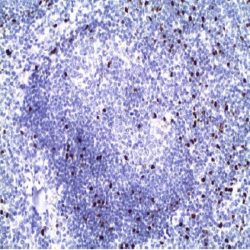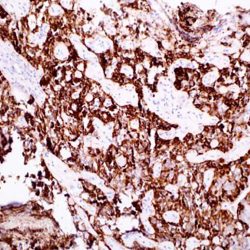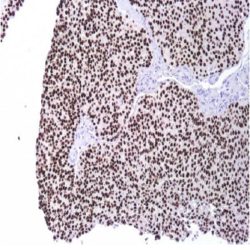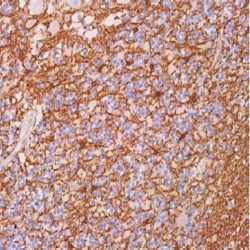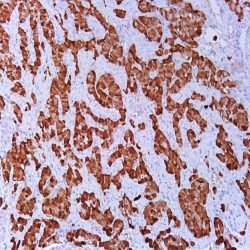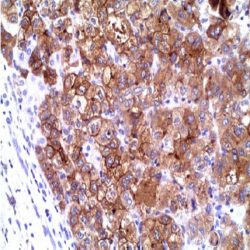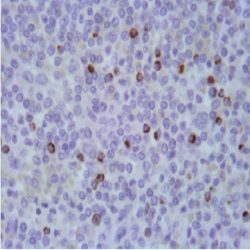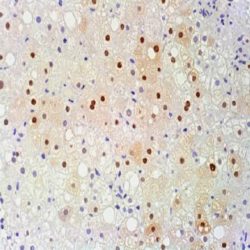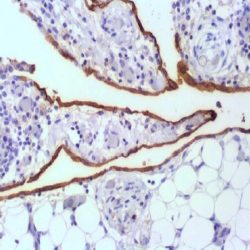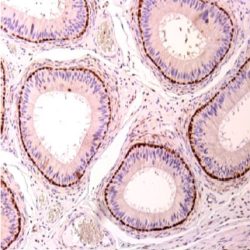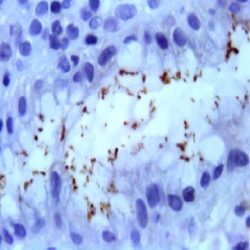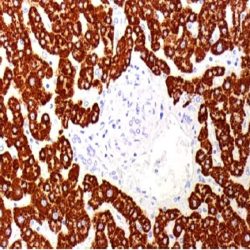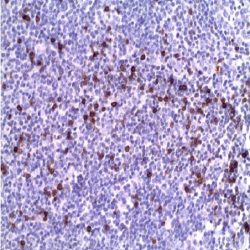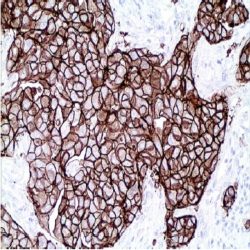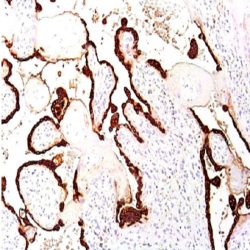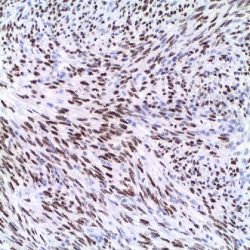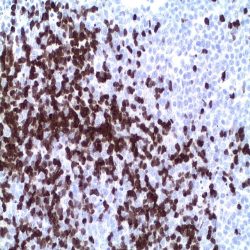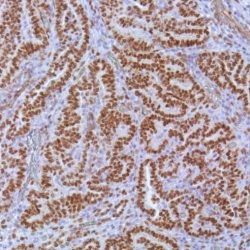دسته: آنتی بادیهای ایمونوهیستوشیمی
نمایش 41–60 از 923 نتیجه
فیلتر ها-
آنتی بادیهای ایمونوهیستوشیمی
آنتی بادی FOXP3 (SP97)
نمره 0 از 5.(Name: FoxP3 Antibody (Clone SP97
Description and aplications: FOX human protein family consists of at least 43 transcription factors, among which is the FoxP3 protein or Scurfin, whose gene is located on Xp11.23 chromosomal region. The proteins of this family are involved in a wide range of processes including control of cell proliferation and differentiation, immune regulation and signal transduction.. Foxp3 plays a very important role in the regulation of T cell activation and acts as transcriptional repressor transactivator suppressing cytokine genes by competition with the NF-AT / AP1 factor controlling the production of cytokines such as IL-2, IL-4, IFN-gamma, TNF-stimulating factor and granulocyte-macrophage colonies (GM-CSF). In addition to the important role that FOXP3 plays in regulating the immune response, recent studies have shown that this molecule can act as a tumor suppressor factor in intraepithelial neoplasia of the prostate, breast (especially in its triple negative variant) and ovarian among other. Generally, FOXP3 expression has dual character, meaning that usually some normal tissues with positive nuclear staining may develop negative tumors and, vice versa, when negative normal tissue occasionally produce positive tumors. This is the case for example of prostatic epithelium and mammary ducts where FOXP3 is expressed constitutively at nuclear level, or pancreatic ducts and melanocytes where staining is negative. In these tumors the presence of numerous positive cells is associated with a poorer response to chemotherapy.
Composition: anti-human FoxP3 rabbit monoclonal antibody purified by protein A/G in PBS/1% BSA buffer pH 7.6 with less than 0.1% sodium azide.
Immunogen: Synthetic peptide corresponding to C-terminus of human FoxP3.
-
آنتی بادیهای ایمونوهیستوشیمی
آنتی بادی FSH (Follicle Stimulating Hormone) (EP257)
نمره 0 از 5(Name: Rabbit anti-human FSH (Follicle Stimulating Hormone) Monoclonal Antibody (Clone EP257
Description and applications: The pituitary glycoprotein hormone family includes follicle-stimulating hormone, luteinizing hormone, chorionic gonadotropin, and thyroid-stimulating hormone. All of these glycoproteins consist of an identical alpha subunit and a hormone-specific beta subunit. FSH beta is the beta subunit of folliclestimulating hormone. In conjunction with luteinizing hormone, follicle-stimulating hormone induces egg and sperm production. The FSH antibody specifically labels Gonadotrophs in pituitatry. It may be useful in the classification of pituitary tumors.
Composition: Anti-human FSH (Follicle Stimulating Hormone) rabbit monoclonal antibody purified from . serum and prepared in 10mM PBS, pH 7.4, with 0.2% BSA and 0.09% sodium azide.
Immunogen: A synthetic peptide corresponding to residues of human FSH (beta subunit) protein.
-
آنتی بادیهای ایمونوهیستوشیمی
آنتی بادی Galectin-3 (B2C10)
نمره 0 از 5.(Name: Galectin 3 Antibody (Clone B2C10
Description and applications: The antibody recognizes a 30 kDa protein member of the family of the beta-galactosidase-binding lctin involved in cell growth, adhesion, inflammation and apoptosis processes. Galectin-3 is expressed in normal inflammatory cells (granulocytes) in vascular endothelium and in primary and metastatic malignancies of the colon, liver, breast, tongue and thyroid. This antibody is useful for differentiating between benign (adenomas) and thyroid malignancies. It may also be useful for the recognition of minimally invasive thyroid lesions. The combined use of Galectin-3 and HBME-1 may be helpful in the differential diagnosis between adenomas and oncocytic thyroid carcinomas. The sensitivity of galectin-3 to detect oncocytic carcinomas and the oncocytic variant of papillary carcinoma is 95%. The medullary carcinomas and normal thyroid follicles do not express galectin-3.
Composition: anti-Galectin 3 mouse monoclonal antibody obtained from supernatant culture and prediluted in a tris buffered solution pH 7.4 containing 0.375mM sodium azide solution as bacteriostatic and bactericidal.
Immunogen: Recombinant protein of the full length od the human Galectin-3 protein.
-
آنتی بادیهای ایمونوهیستوشیمی
آنتی بادی GATA-3 (L50-823)
نمره 0 از 5.(Name: GATA3 Antibody (Clone L50-823
Description and applications: GATA3 (GATA binding protein 3 to DNA sequence [A/T]GATA[A/G]) is a zinc finger transcription factor and plays an important role in promoting and directing cell proliferation, development, and differentiation in many tissues and cell types. GATA3 expression is primarily seen in breast carcinoma and urothelial carcinoma and only rarely found in tumors from other organs, such as endometrial endometrioid adenocarcinoma or yolk sac tumors. In the lymphoid system GATA-3 gene expression promotes receptor T cells and induces the activation of T helper type 2 cells. GATA3 is expressed in all breast lobular carcinomas and 91% of invasive ductal carcinomas (grade I, 100%; grade II, 89% and grade III, 86%1-2). GATA3 expression seems to be lower in luminal B subtype breast carcinoma. It has also been reported that GATA3 expression is correlated with the status of ER, PR and Her2 in breast carcinoma. GATA3 expression is found in urothelial carcinoma, especially in invasive and high grade tumors. Therefore, anti-GATA3 can be used in a panel of antibodies for diagnosis of unknown primary carcinoma, when carcinomas of the breast or bladder are a possibility. Isolated studies have demonstrated the usefulness of GATA-3, together with T-bet marker to differentiate between lymphocytic colitis and celiac disease. In germ cell tumors glandular areas of endodermal and trophoblastic differentiation might be stained. GATA 3 is also positive in many tissues such as parathyroid or salivary gland tumors; mucinous and non-mucinous pancreatic adenocarcinomas, squamous cell carcinomas, basal cell carcinomas, chromophobe carcinomas of the kidney, mesotheliomas, poorly differentiated papillary or mucinous adenocarcinomas of the lung, carcinomas of the stomach, colon, prostate, endometrium, thyroid, serous and Brenner benign and borderline ovarian tumors.
Composition: anti-human GATA3 mouse monoclonal antibody purified from ascites. Prepared in 10mM PBS, pH 7.4, with 0.2% BSA and 0.09% sodium azide.
-
آنتی بادیهای ایمونوهیستوشیمی
آنتی بادی GFAP (GA5)
نمره 0 از 5Name: Mouse anti-human Glial Fibrillary Acidic Protein (GFAP) Monoclonal Antibody
Description and applications: GFAP antibody stains astrocytes, glial cells, ependymal cells and their corresponding tumors. In the peripheral nervous system, Schwann cells, satellite cells, and enteric glial cells are stained. Weak staining of axons has been observed. Absorption studies show that this is caused by a cross-reaction with neurofilament protein. Ab-4 is particularly useful for distinguishing neoplasms of astrocytic origin from other neoplasms in the central nervous system by immunohistochemistry
Composition: anti-human GFAP rabbit polyclonal purified antibody fraction from rabbit anti-serum. Prepared in 10mM PBS, pH 7.4, with 0.2% BSA and 0.09% sodium azide.
Intended use : Immunohistochemistry (IHC) on paraffin embedded tissues. Not tested on frozen tissues or Western-Blotting
Immunogen: GFAP isolated from pig spinal cord
Species reactivity: In vitro diagnostics in humans. Not tested in other species
-
آنتی بادیهای ایمونوهیستوشیمی
آنتی بادی Glucagón (EP74)
نمره 0 از 5.(Name: Glucagon Monoclonal Antibody (Clone EP74
Description and application: Glucagon is synthesized and released by the alpha-cells of the islets of Langerhans’ in pancreas. It regulates blood glucose by increasing gluconeogenesis and decreasing glycolysis, stimulates fluid secretions from the intestine and suppresses the release of gastrin. Antiglucagon is useful in identification of glucagonoma.
Composition: Anti-human Glucagon rabbit monoclonal antibody purified from serum and prepared in 10mM PBS, pH 7.4, with 0.2% BSA and 0.09% sodium azide.
Immunogen: A synthetic peptide corresponding to residues in human Glucagon protein.
-
آنتی بادیهای ایمونوهیستوشیمی
آنتی بادی Glycophorin A (JC159)
نمره 0 از 5.(Name: Glycophorin A Antibody (Clone JC159
Description and aplications: This antibody reacts with a resistant paraffin-embedded and formol fixed epitope located in the extracellular domain of the protein, probably between amino acids 27 and 40. Therefore, this antibody recognizes normal erythroid cells in all stage of differentiation from erythroblasts to mature red blood cells. Once glycophorin A is at its maximum expression, the quantity in each erythroid cell remains constant and shows no change during maturation despite the decreasing size of the cell. The neoplastic erythroblast in most erythroleukemias are identified by Glycophorin A.
Composition: anti-Glycophorin A mouse monoclonal antibody obtained from supernatant culture and prediluted in a tris buffered solution pH 7.4 containing 0.375mM sodium azide solution as bacteriostatic and bactericidal.
Immunogen: membrane preparation from splenic hairy cell leukemia cells.
-
آنتی بادیهای ایمونوهیستوشیمی
آنتی بادی Glypican 3 (1G12)
نمره 0 از 5.(Name: Glypican 3 Antibody (Clone 1G12
Description and applications: Glypican‐3 (GPC3) is a member of the glypican family of glycosyl phosphatidylinositol‐anchored cell‐surface heparin sulfate proteoglycans. The 1G12 monoclonal antibody has been used to assess GPC3 expression in malignant and nonmalignant liver tissue samples and for enzyme‐linked immunosorbent assay (ELISA) for detection of GPC3 in the serum. Studies have shown that GPC3 is expressed at the protein level in most HCCs, but it is undetectable in normal liver and benign hepatic lesions, including dysplastic and cirrhotic nodules. In addition, GPC3 is significantly elevated in the serum of a large proportion of patients with HCC. Based on these results, it has been proposed that GPC3 could be a useful marker to differentiate between benign and malignant liver diseases. The GPC3 is expressed in the great majority of the gonadal yolk sac tumors. The endodermal component of endometrial or ovarian endometrioid carcinoma cases with also show intense cytoplasmic and / or membrane positivity. It is positive in sporadic cases of choriocarcinoma and presents focal positivity in embryonal carcinomas and immature teratomas; is not expressed in seminomas an intratubular germ cell neoplasia. Isolated cases spermatocytic seminomas show weak positivity. Other tumors of gonadal origin that can express GPC3 are endometrioid, clear cell, mucinous or serous carcinomas. 80% of placental site trophoblastic tumors and 100% of uterine placental site nodules are also positive. In other no gynecological tumors, GPC3 is expressed to 23% of lung carcinomas (55% squamous cell carcinomas and only 8% of adenocarcinomas) and 3% of renal cell carcinomas (chromophobe carcinomas). Along with other markers such as E-cadherin (negative) and β-catenin (positive nuclear and cytoplasmic), GPC3 is a useful marker in the diagnosis of pseudopapillary solid tumors of the pancreas and helps the differential diagnosis of neuroendocrine tumors. 34.7% of rhabdomyosarcomas, more frequent embryonal type, show positivity for this antibody while other types of sarcomas arenegative. In a recent study, 52% of liposarcomas and 29% of melanomas have been positive. Varying percentages of other tumors of epithelial and mesenchymal have shown variable positivity, demonstrating the lack of specificity of this antibody and the need to analyze the results in context with other antibodies staining.
Composition: anti-human Glypican 3 mouse monoclonal antibody purified from serum and prepared in 10mM PBS, pH 7.4, with 0.2% BSA and 0.09% sodium azide.
Immunogen: Balb/C mice immunized with a single i.p. injection of 50 μg of a fragment containing the last 70 amino acids of the core protein
-
آنتی بادیهای ایمونوهیستوشیمی
آنتی بادی Granzyme B (GrB-7)
نمره 0 از 5.(Name: Granzyme B Antibody (Clone GrB-7
Description and aplications: This antibody reacts with human Granzyme B. Granzyme B is a neutral serine protease which is stored in granules of specialized cytotoxic T lymphocytes (CD8) and NK cells. From mouse CD8 and NK cells vaious types of granzymes have been identifies and named alphabetically (A-G). They are involved in the apoptosis mediated by the cytotoxic lymphocytes. The exocytosis of granules containing granzyme in the cytoplasm of the target cells leads to DNA fragmentation and subsequent apoptosis. Granzyme B has also been located in EBV positive Reed Sternberg cells of Hodgkin’s disease.
Composition: anti-Granzyme B mouse monoclonal antibody obtained from supernatant culture and prediluted in a tris buffered solution pH 7.4 containing 0.375mM sodium azide solution as bacteriostatic and bactericidal.
Immunogen: Recombinant protein encoding the N-terminus of the mature granzyme B.
-
آنتی بادیهای ایمونوهیستوشیمی
آنتی بادی Hepatitis B Virus Surface Antigen (A10F1)
نمره 0 از 5Name: Hepatitis B Virus Core Antigen (HBVcAg) Polyclonal Antibody
Description and applications: Hepatitis B virus is spherical in shape with a diameter of 42 nm. It contains a 27 nm partially double stranded DNA core enclosed within a lipoprotein coat. The antigenic activity of the nucleocapsid core is designated as hepatitis B core antigen. The antigens in the outer surface are called as hepatitis B virus surface antigens. Core antigens are localized within the nuclei whereas the surface antigens are present in the cytoplasm of the infected cells. Antibodies to surface antigens appear in circulation at an early stage of infection whereas the antibodies to the core antigens are detected after several weeks. This antibody recognizes a protein in the core of hepatitis B virus.
Composition: anti-human HBVcAg rabbit polyclonal antibody fraction from rabbit anti-serum. Prepared in 10mM PBS, pH 7.4, with 0.2% BSA and 0.09% sodium azide.
Immunogen: Hepatitis B virus.
-
آنتی بادیهای ایمونوهیستوشیمی
آنتی بادی HBME-1 (HBME-1)
نمره 0 از 5.(Name: Mesothelial Cell Antibody (Clone HBME-1
Description and aplications: Antibody against HBME-1 stains the cytoplasmic membrane of normal pleural and peritoneal mesothelial cells and mesothelioma. Although both the membrane and the cytoplasm of mesothelioma cells stain positive with HBME-1, a thick membrane pattern turns out to be more useful for the diagnosis of malignant mesothelioma and it correlates with the presence of abundant “microvilli” in the surface membrane of these cells. There are other tissues (both malignant and normal) which are also positive with HBME-1, although immunostaining can be much weaker. Although HBME-1 positivity has been proven in 19 of 50 adenocarcinomas of different origin, the pattern of staining observed was cytoplasmic, although occasionally weak membrane staining also appeared. This antibody shows useful to distinguish malignant lesions of the thyroid (papillary and follicular) of benign lesions (goiter, adenomas, etc..). No cross reaction was observed with tissues such as kidney, liver, lung, ovary and pancreas. Storage and stability: up to 18 months; stored at 2- 8ºC. Do not freeze.
Composition: anti-HBME-1 mouse monoclonal antibody obtained from supernatant culture and prediluted in a tris buffered solution pH 7.4 containing 0.375mM sodium azide solution as bacteriostatic and bactericidal.
-
آنتی بادیهای ایمونوهیستوشیمی
آنتی بادی Heat Shock Protein 70 (HSP70) (W27)
نمره 0 از 5Name: Heat Shock Protein 70 (HSP70) Monoclonal Antibody clone W27
Description and applications: Heat shock proteins (HSP’s) or stress response proteins (SRP’s) are synthesized in variety of environmental and pathophysiological stressful conditions. Many HSP’s are involved in processes such as protein denaturation-renaturation, folding-unfolding, transporttranslocation, activation-inactivation, and secretion.HSP70 is found to be associated with steroid receptors, actin, p53, polyoma T antigen, nucleotides, and other unknown proteins. Also, HSP70 has been shown to be involved in protective roles against thermal stress, cytotoxic drugs, and other damaging conditions. This antibody recognizes both the constitutive (HSP73), and inducible (HSP72) forms of HSP70. Most normal cells show moderate cytoplasmic and nuclear immunostaining. Pancreatic islets, cardiac muscle cells and most CNS cells are weakly stained or negative. HSP70 in tumors is significantly increased in patients with cholangiocarcinoma. HSP70 is positive in the majority of the hepatocellular carcinoma. In oral squamous cell carcinomas HSP70 expression has been associated with increased survival compared with HSP70 negative tumors, suggesting that low HSP70 expression in epidermoid carcinomas require more aggressive treatment.
Composition: anti-human HSP70 rabbit monoclonal antibody purified from serum and prepared in 10mM PBS, pH 7.4, with 0.2% BSA and 0.09% sodium azide
Immunogen: HSP70 protein from HeLa cells
Species reactivity: In vitro diagnostics in humans. Not tested in other species
-
آنتی بادیهای ایمونوهیستوشیمی
آنتی بادی Helicobacter Pylori (Polyclonal)
نمره 0 از 5Name: Helicobacter Pylori Polyclonal Antibody
Description and applications: This antibody detects the Campylobacter jejuni, although some of the Campylobacter jejuni flagellar antigens are shared by other subspecies of Campylobacters like Helicobacter pylori.
Composition: anti-Helicobacter Pylori rabbit polyclonal antibody obtained from supernatant culture and prediluted in a tris buffered solution pH 7.4 containing 0.375mM sodium azide solution as bacteriostatic and bactericidal.
Immunogen: Purified Helicobacter Pylori
-
آنتی بادیهای ایمونوهیستوشیمی
آنتی بادی Hepatocyte Specific Antigen (Hep Par 1) (OCH1E5)
نمره 0 از 5Name: Hepatocyte Specific Antigen (Hep Par 1) Antibody (Clone OCH1E5)
Description and applications: Anti-hepatocyte specific antigen, also known as anti-Hep-Par1, recognizes both benign and malignant liver-derived tissues including such tumors as hepatoblastoma, hepatocellular carcinoma (including its fibrolamellar variant), and hepatic adenoma. It recognizes both normal adult and fetal liver tissue. The typical pattern is a granular cytoplasmic staining. This antibody is useful in differentiating hepatocellular carcinomas with adenoid features from adenocarcinomas, either primary in the liver or metastatic lesions to the liver. In labeling hepatoblastoma, it is useful in differentiating this entity from other small round cell tumors. No reaction is usually seen with other human tumors with the exception of some gastrointestinal tumors. Occasionally it might be expressed by some tumors which include adrenal carcinomas, yolk sac tumors, adenocarcinomas of the colon, lung, ovarian carcinomas and adenocarcinomas of the endocervix.
Composition: anti-human HepPar 1 mouse monoclonal antibody purified from ascites. Prepared in 10mM PBS, pH 7.4, with 0.2% BSA and 0.09% sodium azide.
-
آنتی بادیهای ایمونوهیستوشیمی
آنتی بادی TCR B (G-11)
نمره 0 از 5.(Name: TCR beta Antibody (Clone G-11
Description and applications: The T cell antigen receptor (TCR) recognizes foreign antigens and translates such recognition events into intracellular signals that elicit a change in the cell from a dormant to an activated state. TCR is a heterodimer composed of either α and β or γ and δ chains. The vast majority of circulating T cells (95%) express the α/β heterodimer while roughly 2-5% express the γ/δ heterodimer.
Composition: anti-human TCR beta mouse monoclonal antibody purified from serum and prepared in 10mM PBS, pH 7.4, with 0.2% BSA and 0.09% sodium azide.
Immunogen: human constant region of T cell receptor beta.
-
آنتی بادیهای ایمونوهیستوشیمی
آنتی بادی C-erbB-2/HER2/NEU (SP3)
نمره 0 از 5Name: Rabbit Anti-c-erbB2 Monoclonal Antibody clone SP3
Description and applications: C-erbB-2 is a receptor tyrosine kinase of the c-erbB family. The C-erbB-2 is a proto-oncogene located on human chromosome 17, band 21. It has structural similarities to the EGFR (Epidermal Growth Factor Receptor). Immunohistochemical staining of the oncoprotein is related to gene amplification. Different studies have demonstrated immunohistochemical detectable levels in more than 20% of adenocarcinomas of different locations, including ovarian, gastro-intestinal tract and breast. In the case of breast cancer, the overexpression has been shown to be associated with poor prognosis. This antibody is recommended to determine the expression levels of the oncoprotein C-erb B-2 in breast adenocarcinomas and other locations.
Composition: anti-cerbB2 rabbit monoclonal antibody obtained from supernatant culture and prediluted in a tris buffered solution pH 7.4 containing 0.375mM sodium azide solution as bacteriostatic and bactericidal. Intended use : Immunohistochemistry (IHC) on paraffin embedded tissues. Not tested on frozen tissues or Western-Blotting
Immunogen: Recombinant protein encoding extracellular domain of human c-erbB2
Species reactivity: In vitro diagnostics in humans. Not tested in other species
-
آنتی بادیهای ایمونوهیستوشیمی
آنتی بادی HPL (Human Placental Lactogen) (Polyclonal)
نمره 0 از 5Name: Placental Lactogen (hPL) Polyclonal Antibody
Description and applications: Human placental lactogen (hPL) is known to originate in the syncytiotrophoblasts. Ultrastructural localization indicates that placental lactogen is stored in small morphologically distinctcytoplasmic granules within these cells and has adifferent secretory mechanism from other hormonal peptides such as human chorionic gonadotropin.
The level of expression of placental lactogen through pregnancy increases gradually to term. Immunostaining for hPL is useful for the differential diagnosis of choriocarcinoma where it is expressed in most cases, placental site trophoblastic tumour and the trophoblastic pseudotumoral lesions such as placental site nodule and exaggerated placental site reaction.
Composition: anti-human Placental Lactogen rabbit polyclonal antibody purified from rabbit anti-serum. Prepared in 10mM PBS, pH 7.4, with 0.2% BSA and 0.09% sodium azide
Immunogen: Purified human placental lactogen
-
آنتی بادیهای ایمونوهیستوشیمی
آنتی بادی Human Herpes Virus 1+2 (Polyclonal)
نمره 0 از 5Name: Herpes Simplex Virus I+II Antibody (Polyclonal)
Description and applications: Herpes viruses type 1 and 2 (HSV-1 and HSV-2) belong to the family of herpesviridae. Its genome consists of a linear double molecule of DNA of approximately 100,000 kD encoding more than 75 gene products. The homology between the genomic structure of HSV-1 and 2 is ofapproximately 50%, so that while most of the polypeptides encoded for each type of herpes virus have a similar structure and are antigenically related, there are numerous proteins of both viruses that condition particular responses of the host’s immune system and allow its serological and immunohistochemical differentiation. The monoclonal antibody described herein reacts with the herpes simplex virus type 2 and is useful in detecting HSV II induced lesions. At high concentrations, cross-reactivity has been observed against some strains of the varicella zoster virus. The antibody does not react against CMV or Epstein- Barr virus cultures.
Composition: anti-human Herpes Simplex Virus I+II rabbit polyclonal antibody purified from serum and prepared in 10mM PBS, pH 7.4, with 0.2% BSA and 0.09% sodium azide.
-
آنتی بادیهای ایمونوهیستوشیمی
آنتی بادی ZAP-70 (2F3.2)
نمره 0 از 5(Name: ZAP-70 Antibody (Clone 2F3.2
Description and applications:ZAP-70 is a 70kDa protein tyrosine kinase found in T-cells and natural killer cells. Control of this protein translation is via the IgVH gene. In Western blotting of whole cell lysates of normal peripheral blood mononuclear cells, the antibody labels a band corresponding to ZAP-70. In Western blotting of whole cell lysates of CD19- positive purified leukemia cells from patients with lgunmutated and lg-mutated CLL, the antibody labels a band corresponding to ZAP-70 in the Ig-unmutated CLL samples, whereas no band is observed in the Igmutated CLL samples. In Western blotting of cell lysates of Jurkat cells (T-lymphoblastic cell line), the antibody labels a band of 70kDa protein. In Western blotting of cell lysates of A431 cells (carcinoma cell line), no band is observed. ZAP-70 protein is expressed in leukemic cells of approximately 25% ofchronic lymphocytic leukemia (CLL) cases as well. Anti-ZAP-70 expression is an excellent surrogate marker for the distinction between the g-mutated (anti-ZAP-70 negative) and Ig-unmutated (anti-ZAP-70 positive) CLL subtypes and can identify patient groups with divergent clinical courses. The anti-ZAP-70 positive Ig-unmutated CLL cases have been shown to have a poorer prognosis.
Composition: Anti-human ZAP-70 mouse monoclonal antibody purified from serum and prepared in 10mM PBS, pH 7.4, with 0.2% BSA and 0.09% sodium azide.
Immunogen: Recombinant ZAP-70 protein including residues 1-254 and encompassing SH2 domains of human ZAP-70.
-
آنتی بادیهای ایمونوهیستوشیمی
آنتی بادی WT1 (Wilms Tumor) (6F-H2)
نمره 0 از 5(Name: WT-1 (Wilm´s Tumour Protein 1)Antibody (Clone 6F-H2
Description and aplications: WT-1 gene is located on chromosome 11p13 and is involved in the development of Wilm´s tumor (WT). WT is associated with mutations of WT1, a zinc-finger transcription factor that is essential for the development of the metanephric kidney and the urogenital system. The WT1 gene is normally expressed in fetal kidney and mesothelium, and its expression has been suggested as a marker for Wilms tumor and mesothelioma. Anti-WT1 is useful in the diagnosis of malignant mesotheliomas (nuclei) while the nuclei of lung adenocarcinomas are not labeled with this product. However, cytoplasmic labeling of lung adenocarcinomas
may be observed. Anti-WT1 labels 93% of serousovarian carcinomas and 0% (nuclei) of mucinous carcinomas of the ovary and pancreato-biliary carcinomas. Anti-WT1 can also be utilized in the differential diagnosis of small round cell tumors as 100% of desmoplastic small round cell tumors and 70% of nephroblastomas (Wilm’s tumor) are positive (nuclei) for this marker. Tumors such as Ewings sarcoma/PNET, neuroblastomas, rhabdomyosarcomas, and rhabdoid tumors are negative. Occasionally cytoplasmic labeling may be seen in these tumors, however.Composition: anti-human WT-1 mouse monoclonal antibody obtained from tissue culture supernatant prepared in 10mM PBS, pH 7.4, with 0.2% BSA and 0.09% sodium azide.
Immunogen: Truncated human WT1 protein corresponding to aa 1-181.

